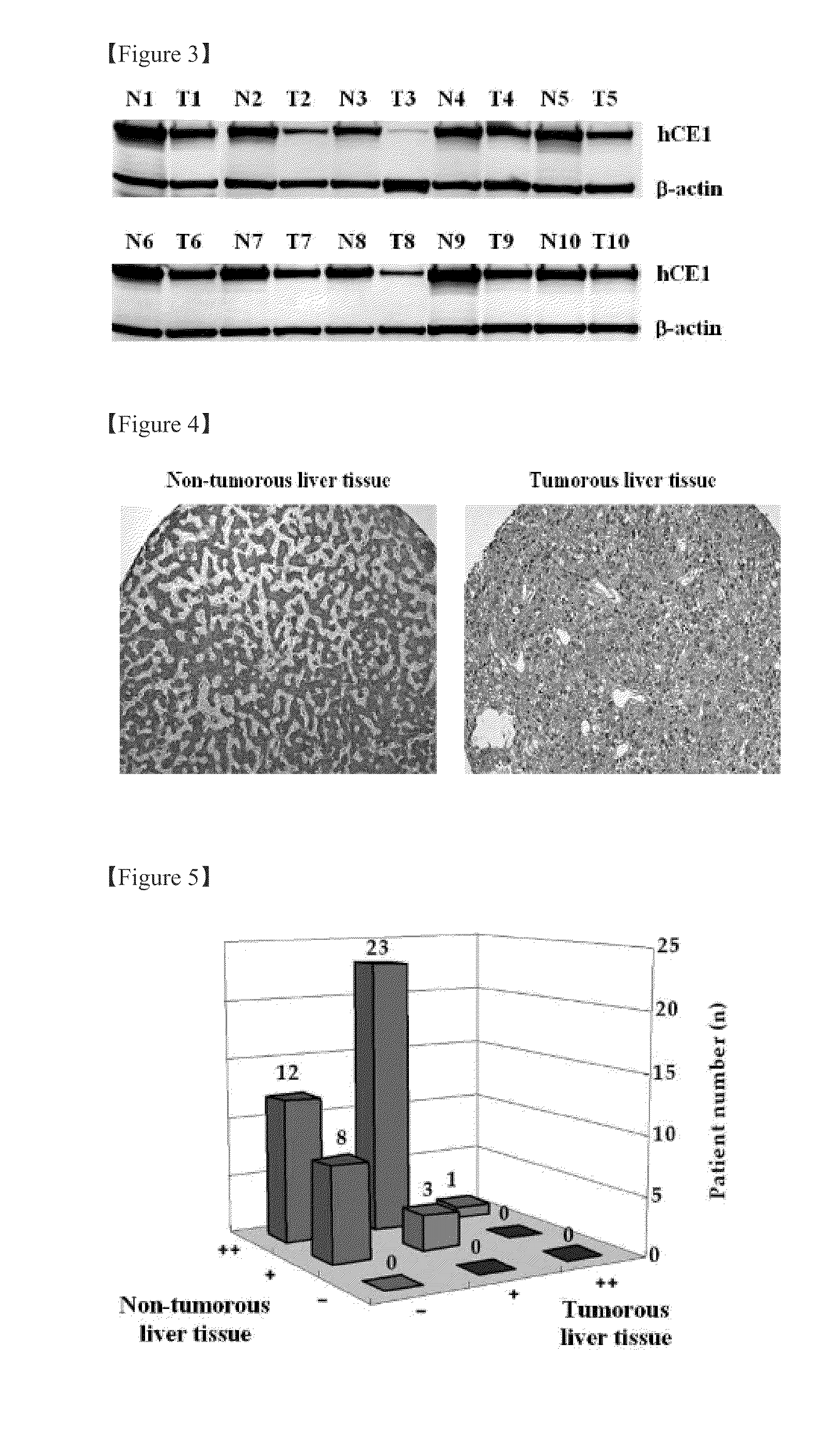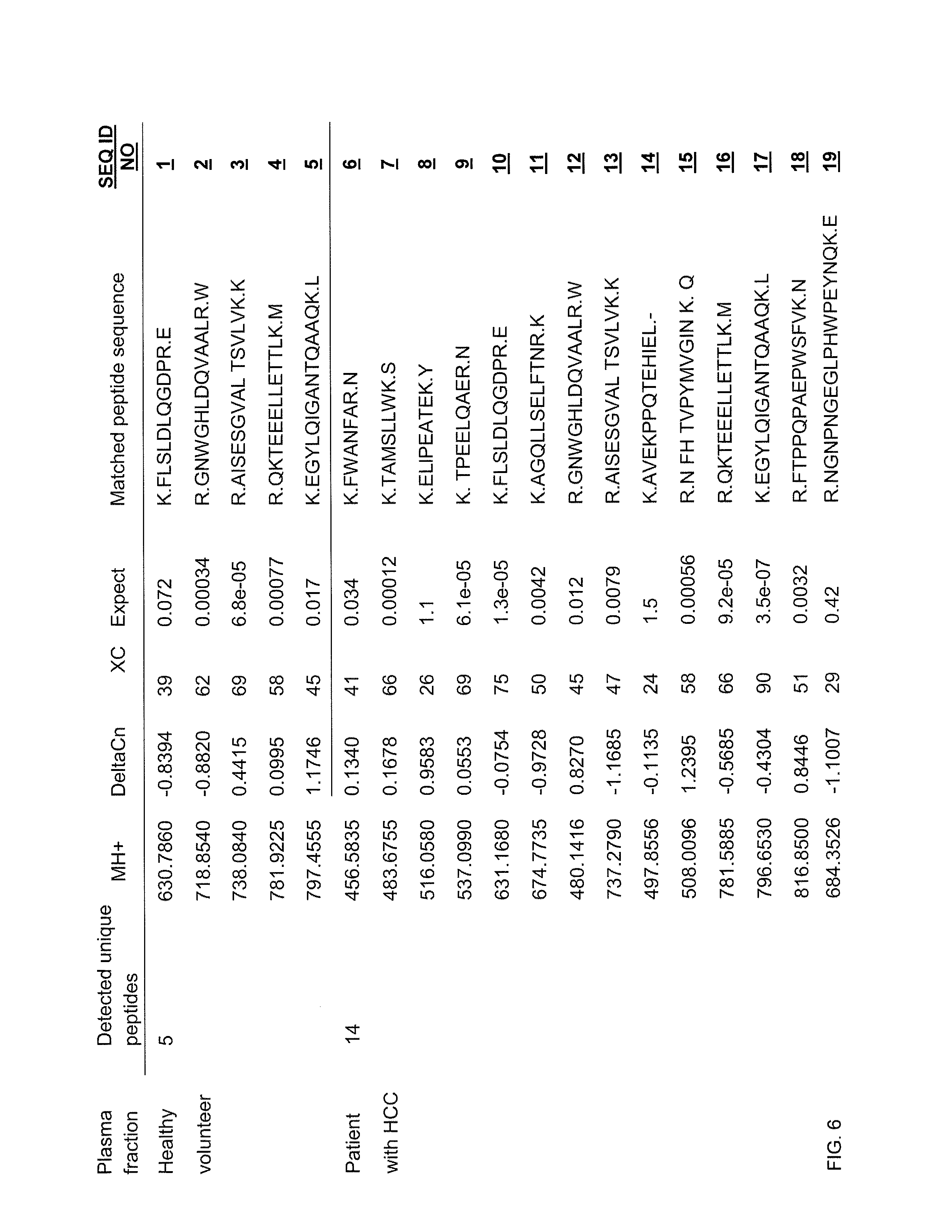Plasma biomarker tool for the diagnosis of liver cancer comprising liver carboxylesterase 1 and liver cancer screening method
a liver cancer and carboxylesterase technology, applied in biochemistry equipment and processes, instruments, material analysis, etc., can solve the problems of poor sensitivity and/or specificity, low survival rate after diagnosis, and difficulty in early-stage diagnosis of liver cancer, so as to effectively detect the presence of hcc
- Summary
- Abstract
- Description
- Claims
- Application Information
AI Technical Summary
Benefits of technology
Problems solved by technology
Method used
Image
Examples
embodiment 1
[0041] Collection of Clinical Tissues and Plasma
[0042]The non-tumorous and tumorous liver tissue from patients with HCC were obtained along with pathological individual information from the Department of Pathology, Yonsei University College of Medicine, Seoul, Korea. The following tests were used to assess the appropriateness of plasma from healthy volunteers to serve as a negative control: HIV-1 and HIV-2 antibodies derived from HIV, which is a liver-cancer indicating standard test element; HIV-1 antigen; hepatitis B surface antigen; hepatitis B core antigen; hepatitis C virus; T-Cell Leukemia Virus (HTLV-I / II) antigen; and Treponema pallidum. Plasma was obtained according to a standardized sample separation method formally adopted by the Human Proteome Organization (HUPO).
[0043]Each blood sample (4 ml) from man or woman was maintained in a tube containing di-potassium ethylenediamine tetraacetic acid (K2EDTA) for 30 minutes at room temperature, followed by centrifugation for 15 mi...
embodiment 2
[0044] Separation of Glycoproteins in Non-Tumorous and Tumorous Liver Tissue
[0045]A 100 mg sample of each tissue was homogenized in RIPA buffer (50 mM Tris, 150 mM NaCl, 1% Nonidet P-40, 0.25% sodium deoxycholate, pH 7.4) at 4° C. Glycoproteins were separated by lectin-affinity chromatography using a mixture of five different agarose-bound lectins: concanavalin A, wheat germ agglutinin, Jacalin, Sambucus nigra, and Aleuria aurantia. The lectin mixture, with binding specificities for glycoproteins with different sugar compositions, was packed into a 2 ml PD-10 column (Pierce). Glycoprotein-containing samples were applied to the column in binding buffer (20 mM Tris, 1 mM MnCl2, 1 mM CaCl2, 0.15 M NaCl, pH 7.4) and allowed to interact with the column for 30 minutes.
[0046]The bound glycoproteins were eluting with a buffer (0.2 M methyl-D-mannopyroside, 0.2 M methyl-D-glucopyroside, 0.2 M N-acetylglucosamine, 0.2 M galactose, 0.1 M lactose, 0.1 M fucose, 20 mM Tris, 0.5 M NaCl, pH 7.0) t...
embodiment 7
[0060] Validation of HCC Biomarker Protein Secretion Level in Human Plasma by Immunoprecipitation and Western Blot Analysis
[0061]Dynabead MyOne™ Tosylactivated (Invitrogen) magnetic beads were coated with anti-hCE1 antibody as described by the manufacturer. Briefly, magnetic beads (10 mg) and anti-hCE1 antibody (400 μg) were mixed and incubated for 16 hours in binding buffer (0.1 M sodium borate, 1 M ammonium sulfate, pH 9.5) at 37° C., and then blocked with TBS-T / 5% skim milk for an additional 16 hours. hCE1 was immunoprecipitated from the plasma of healthy volunteers and patients with HCC by transferring antibody-coated beads (500 μg) to l ml tubes containing 8 mg plasma and incubating for 2 hours.
[0062]Antibody-bound proteins were eluted by adjusting the pH of the TBS-T buffer to pH 2. Differences in hCE1 levels between the plasmas of healthy volunteers and patients with HCC were determined by Western blot analysis using a primary anti-hCE1 antibody (Abcam; 1:1000) and a secondar...
PUM
| Property | Measurement | Unit |
|---|---|---|
| pH | aaaaa | aaaaa |
| pH | aaaaa | aaaaa |
| volume | aaaaa | aaaaa |
Abstract
Description
Claims
Application Information
 Login to View More
Login to View More - R&D
- Intellectual Property
- Life Sciences
- Materials
- Tech Scout
- Unparalleled Data Quality
- Higher Quality Content
- 60% Fewer Hallucinations
Browse by: Latest US Patents, China's latest patents, Technical Efficacy Thesaurus, Application Domain, Technology Topic, Popular Technical Reports.
© 2025 PatSnap. All rights reserved.Legal|Privacy policy|Modern Slavery Act Transparency Statement|Sitemap|About US| Contact US: help@patsnap.com



